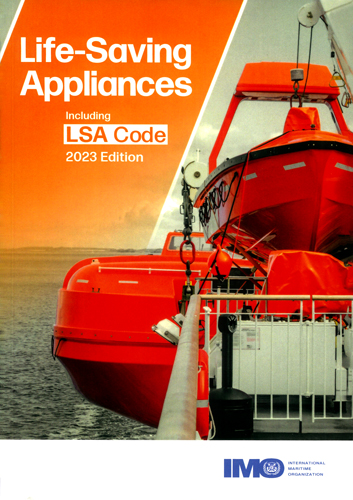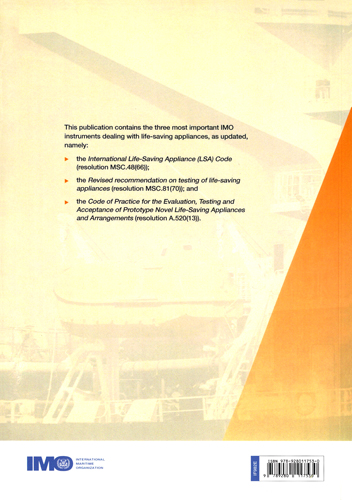Life-Saving Appliances including LSA Code/Спасательные средства, включая Международный кодекс по спасательным средствам
Книга на английском языке.
This publication contains the three most important International Maritime Organization (IMO) instruments dealing with life-saving appliances, namely the International Life-Saving Appliance (LSA) Code , the Revised recommendation on testing of life-saving appliances and the Code of Practice for the Evaluation, Testing and Acceptance of Prototype Novel Life-Saving Appliances and Arrangements. The International Life-Saving Appliance (LSA) Code was adopted by IMO's Maritime Safety Committee (MSC) at its 66th session (June 1996) by resolution MSC.48(66). It provides international requirements for the life-saving appliances required by chapter III of the 1974 SOLAS Convention , including personal life-saving appliances like lifebuoys, lifejackets, immersion suits, anti-exposure suits and thermal protective aids; visual aids, such as parachute flares, hand flares and buoyant smoke signals; survival craft, such as liferafts and lifeboats; rescue boats; launching and embarkation appliances and marine evacuation systems line-throwing appliances; and general alarm and public address systems.
Contents
Foreword
International Life-Saving Appliance (LSA) Code
Resolution MSC.48(66)
Preamble
Chapter I General
1.1 Definitions
1.2 General requirements for life-saving appliances
Chapter II Personal life-saving appliances
2.1 Lifebuoys
2.2 Lifejackets
2.3 Immersion suits
2.4 Anti-exposure suits
2.5 Thermal protective aids
Chapter III Visual signals
3.1 Rocket parachute flares
3.2 Hand flares
3.3 Buoyant smoke signals
Chapter IV Survival craft
4.1 General requirements for liferafts
4.2 Inflatable liferafts
4.3 Rigid liferafts
4.4 General requirements for lifeboats
4.5 Partially enclosed lifeboats
4.6 Totally enclosed lifeboats
4.7 Free-fall lifeboats
4.8 Lifeboats with a self-contained air support system
4.9 Fire-protected lifeboats
Chapter V Rescue boats
5.1 Rescue boats
Chapter VI Launching and embarkation appliances
6.1 Launching and embarkation appliances
6.2 Marine evacuation systems
Chapter VII Other life-saving appliances
7.1 Line-throwing appliances
7.2 General alarm and public address system
Testing and Evaluation of Life-Saving Appliances
I Revised recommendation on testing of life-saving appliances
Resolution MSC.81(70)
Introduction
Part 1 Prototype tests for life-saving appliances
1 Lifebuoys
1.1 Lifebuoys specification
1.2 Temperature cycling test
1.3 Drop test
1.4 Test for oil resistance
1.5 Fire test
1.6 Flotation test
1.7 Strength test
1.8 Test for operation with a light and smoke signal
1.9 Lifebuoy self-activating smoke signal tests
2 Lifejackets
2.1 Temperature cycling test
2.2 Buoyancy test
2.3 Fire test
2.4 Tests of components other than buoyancy materials
2.5 Strength tests
2.6 Tests for lifejacket buoyancy material
2.7 Donning test
2.8 Water performance tests
2.9 Infant and children's lifejacket tests
2.10 Tests for inflatable lifejackets
3 Immersion suits, anti-exposure suits and thermal protective aids
3.1 Tests common to non-insulated and insulated immersion suits and anti-exposure suits
3.2 Thermal protective tests
3.3 Thermal protective aids for survival craft
4 Pyrotechnics - rocket parachute flares, hand flares and buoyant smoke signals
4.1 General
4.2 Temperature tests
4.3 Water and corrosion resistance test
4.4 Handling safety test
4.5 Safety inspection
4.6 Rocket parachute flares test
4.7 Hand flares test
4.8 Buoyant smoke signals test
5 Liferafts - rigid and inflatable
5.1 Drop test
5.2 Jump test
5.3 Weight test
5.4 Towing test
5.5 Mooring out tests
5.6 Liferaft painter system test
5.7 Loading and seating test
5.8 Boarding and closing arrangement test
5.9 Stability test
5.10 Manoeuvrability test
5.11 Swamp test
5.12 Canopy closure test
5.13 Buoyancy of float-free liferafts
5.14 Detailed inspection
5.15 Weak link test
5.16 Davit-launched liferafts - strength test of lifting components
5.17 Additional tests applicable to inflatable liferafts only
5.18 Additional tests applicable to automatically self-righting liferafts only
5.19 Submergence test for automatically self-righting and canopied reversible liferafts
5.20 Wind velocity tests
5.21 Test for self-draining of floors of canopied reversible liferafts and automatically self-righting liferafts
5.22 Liferaft light tests
6 Lifeboats
6.1 Definitions and general conditions
6.2 Lifeboat material tests
6.3 Lifeboat overload test
6.4 Davit-launched lifeboat impact and drop test
6.5 Free-fall lifeboat free-fall test
6.6 Lifeboat seating strength test
6.7 Lifeboat seating space test
6.8 Lifeboat freeboard and stability tests
6.9 Release mechanism test
6.10 Lifeboat operational test
6.11 Lifeboat towing and painter release test
6.12 Lifeboat light tests
6.13 Canopy erection test
6.14 Additional tests for totally enclosed lifeboats
6.15 Air supply test for lifeboats with a self-contained air support system
6.16 Additional tests for fire-protected lifeboats
6.17 Measuring and evaluating acceleration forces
7 Rescue boats and fast rescue boats
7.1 Rigid rescue boats
7.2 Inflated rescue boats
7.3 Rigid/inflated rescue boats
7.4 Rigid fast rescue boats
7.5 Inflated fast rescue boats
7.6 Rigid/inflated fast rescue boats
7.7 Outboard motors for rescue boats
8 Launching and embarkation appliances
8.1 Testing of davits and launching appliances
8.2 Davit-launched liferaft automatic release hook test
9 Line-throwing appliances
9.1 Test for pyrotechnics
9.2 Function test
9.3 Line tensile test
9.4 Visual examination
9.5 Temperature test
10 Position-indicating lights for life-saving appliances
10.1 Survival craft and rescue boats light tests
10.2 Lifebuoy self-igniting light tests
10.3 Lifejacket light tests
10.4 Common tests for all position-indicating lights
11 Hydrostatic release units
11.1 Visual and dimensional examination
11.2 Technical tests
11.3 Performance test
12 Marine evacuation systems
12.1 Materials
12.2 Marine evacuation system container
12.3 Marine evacuation passage
12.4 Marine evacuation platform, if fitted
12.5 Associated inflatable liferafts
12.6 Performance
13 Searchlights for lifeboats and rescue boats
13.1 Visual examination
13.2 Durability and resistance to environmental conditions
13.3 Operational controls
13.4 Light tests
Part 2 Production and installation tests
1 General
2 Individual buoyancy equipment
2.1 Lifejackets
2.2 Immersion and anti-exposure suits
3 Portable buoyancy equipment
3.1 Lifebuoys
4 Pyrotechnics
5 Survival craft
5.1 Liferaft operational inflation test
5.2 Davit-launched liferaft and inflated rescue boat test
5.3 Lifeboat and rescue boat test
5.4 Launch test
6 Launching and stowage arrangements
6.1 Launching appliances using falls and winches
6.2 Installation tests of liferaft launching appliances
7 Marine evacuation systems
7.1 Installation tests
Annex 1 - Adult reference test device (RTD) design and construction
1 General
2 Materials
3 Construction
Annex 2 - Child reference test device (RTD) design and construction
1 General
2 Materials
3 Construction
Annex 3 - Infant reference test device (RTD) design and construction
1 General
2 Materials
3 Construction
II Code of Practice for the Evaluation, Testing and Acceptance of Prototype Novel Life-Saving Appliances and Arrangements
Resolution A.520(13)
Preamble
1 General provisions
2 General criteria
3 Appliance criteria and testing of prototypes
Additional information
Prospective amendments applicable to life-saving appliances Resolution MSC.535
Amendments to the International Life-Saving Appliance (LSA) Code
Resolution MSC.544
Amendments to the Revised recommendation on testing of life-saving appliances (resolution MSC.81 (70))




